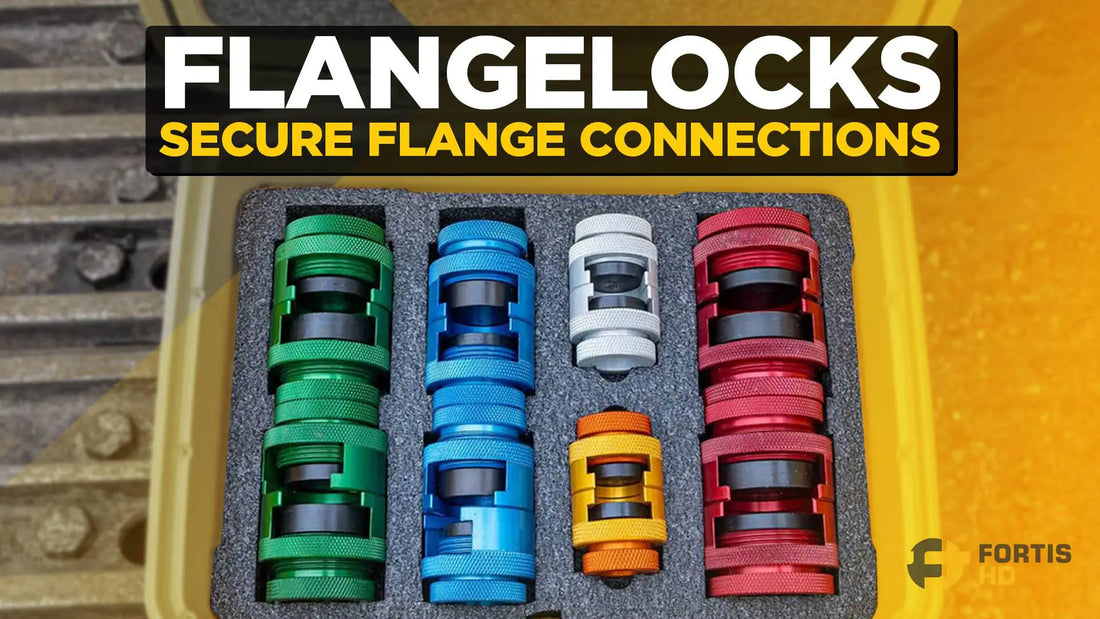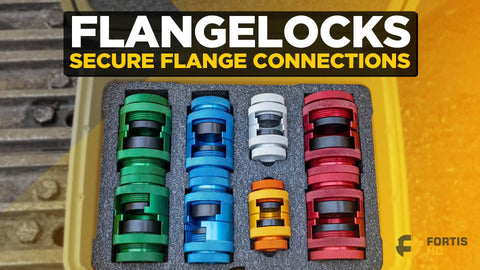
FlangeLocks: The Tool to Seal Flange Connections Effectively and Safely
Written by Luis Montes
Updated On October 08, 2025

Featured Tools
+

Written by Luis Montes
Updated On October 08, 2025

+
While doing the periodic maintenance on your construction equipment, you’ll come across three types of hydraulic connections:

Unlike quick couplers with a self-sealing mechanism, threaded and flange connections spill oil when you disconnect them.
A plug is enough to stop the spilling of unplugged threaded male fittings. However, when it comes to flange connections, most people might fall into the impulse of shoving a rag into the male fitting and the open port.
Don’t do that. First, you won’t prevent oil from spilling out, and second, you’ll likely contaminate the hydraulic system with debris. FlangeLocks are the go-to tool for effectively and securely sealing flange connections.
We’ll discuss the benefits of FlangeLocks for hydraulic maintenance, equipment compatibility, and product specifications.

The FlangeLock is a two-piece seal made of a sleeve and a plug, which screws together to cap a disconnected hose temporarily. FlangeLocks can also include slugs to plug the open port.

FlangeLocks work with captive (one-piece) and splitSAE J518 Code 61,Code 62, andCat-stylehydraulic flangeconnections varying from -08 to -56 (dash 08 to dash 56). Let’s see what all that means.
Code 61 and Code 62 are simply names for specific hydraulic flange connections whose designs comply with the specifications of the SAE J518 standards. The SAE J518 standard, developed by the Society of Automotive Engineers (SAE), specifies dimensions for hydraulic flanges used in high-pressure hydraulic systems.
Code 61 flanges connect pipes, tubes, and hoses for low-pressure applications and have a working pressure of up to 3,000 PSI. On the other hand, Code 62 adapters handle up to 6,000 PSI for more demanding, high-pressure conditions.
Cat-style fittings, often called Caterpillar-style flanges, are similar to Code 62 flanges but feature a thicker flange head and sometimes require specialized flange halves while still using the same bolt pattern as Code 62.
The following tables show the dimension differences between the 3 types of flanges.

| SAE Code 61 | ||||
|---|---|---|---|---|
| Nominal Flange Size (in) | Flange OD (in / mm) |
A (in / mm) |
B (in / mm) |
C (in / mm) |
| 1/2 | 1.19 / 30.2 | 0.69 / 17.5 | 1.50 / 38.1 | 0.265 / 6.73 |
| 5/8 * | 1.35 / 6.73 | 0.265 / 6.73 | ||
| 3/4 | 1.50 / 38.1 | 0.88 / 22.2 | 1.88 / 47.6 | 0.265 / 6.73 |
| 1 | 1.75 / 44.5 | 1.03 / 26.2 | 2.06 / 52.4 | 0.315 / 8.00 |
| 1 1/4 | 2.00 / 50.8 | 1.19 / 30.2 | 2.31 / 58.7 | 0.315 / 8.00 |
| 1 1/2 | 2.38 / 60.3 | 1.41 / 35.7 | 2.75 / 69.8 | 0.315 / 8.00 |
| 2 | 2.81 / 71.4 | 1.69 / 42.9 | 3.06 / 77.8 | 0.375 / 9.53 |
| 2 1/2 | 3.31 / 84.1 | 2.00 / 50.8 | 3.50 / 88.9 | 0.375 / 9.53 |
| 3 | 4.00 / 101.6 | 2.44 / 62.0 | 4.19 / 106.4 | 0.375 / 9.53 |
| 3 1/2 | 4.50 / 114.3 | 2.75 / 70 | 4.75 / 120.7 | 0.422 / 10.72 |
| 4 | 5.00 / 127 | 3.06 / 77.7 | 5.13 / 130.3 | 0.442 / 11.23 |
| 5 | 6.00 / 152.4 | 3.63 / 92.2 | 6.00 / 152.4 | 0.442 / 11.23 |
| SAE Code 62 | ||||
|---|---|---|---|---|
| Nominal Flange Size (in) | Flange OD (in / mm) |
A (in / mm) |
B (in / mm) |
C (in / mm) |
| 1/2 | 1.25 / 31.8 | 0.72 / 18.2 | 1.59 / 40.5 | 0.305 / 7.75 |
| 3/4 | 1.63 / 41.4 | 0.94 / 23.8 | 2.00 / 50.8 | 0.345 / 8.76 |
| 1 | 1.88 / 47.8 | 1.09 / 27.8 | 2.25 / 57.2 | 0.375 / 9.53 |
| 1 1/4 | 2.13 / 54.1 | 1.25 / 31.8 | 2.63 / 66.8 | 0.405 / 10.29 |
| 1 1/2 | 2.50 / 63.5 | 1.44 / 36.5 | 3.13 / 79.5 | 0.495 / 12.57 |
| 2 | 3.13 / 79.5 | 1.75 / 44.5 | 3.81 / 96.8 | 0.495 / 12.57 |
| Cat Style | ||||
|---|---|---|---|---|
| Nominal Flange Size (in) | Flange OD (in / mm) |
A (in / mm) |
B (in / mm) |
C (in / mm) |
| 3/4 | 1.63 / 41.4 | 0.94 / 23.9 | 2.00 / 50.8 | 0.560 / 14.22 |
| 1 | 1.88 / 47.8 | 1.09 / 27.7 | 2.25 / 57.2 | 0.560 / 14.22 |
| 1 1/4 | 2.13 / 54.1 | 1.25 / 31.8 | 2.63 / 66.8 | 0.560 / 14.22 |
| 1 1/2 | 2.50 / 63.5 | 1.44 / 36.6 | 3.13 / 79.5 | 0.560 / 14.22 |
| 2 | 3.13 / 79.5 | 1.75 / 44.5 | 3.81 / 96.8 | 0.560 / 14.22 |
* The -10 size, common outside of North America, is not an SAE standard size (generally found on Komatsu equipment).
As mentioned, FlangeLocks are available in several dash sizes. A hydraulic dash measurement of a flange fitting refers to the diameter expressed in 1/16th-inch values.
So dash 8 or -8 (our FlangeLock smallest size) equals 8 * 1/16th-inch = 1/2 inch. Based on the same calculation, dash 12 equals 3/4 inch, dash 16 equals 1 inch, and so on.

FangeLocks will save you time, oil, and money.
Unlike “sealing” with plastic caps or rags, you’ll eliminate hydraulic oil spills.
Installing FlangeLocks doesn’t require extra tools or hardware. If needed, it could even be a one-hand process. They also protect the fittings from getting banged up or losing the O-ring.
Plus, FlangeLocks are the ultimate contamination control tool, reducing the entry of microscopic debris and particles, which, according to several case studies, such as the one conducted by the Faculty of Mechanical Engineering of the University of Ljubljana, Slovenia, highly degrade the performance of internal components.
The hydraulic measurement results showed that a hydraulic pump tested with a specific concentration of wear particles could operate for 624 hours, while a pump tested with a similar concentration of test dust failed after 5.3 minutes of operation!
The following video from Caterpillar delves into the harmful effects of microscopic debris in heavy equipment’s hydraulic system.

FlangeLock Kits offers an innovative solution for maintaining the cleanliness and integrity of hydraulic systems.
Visit the Fortis HD tool section to choose from one of the nine FlangeLock kits available.

We’ll break down what you’ll see on our tool webpage to help you easily choose according to your needs from the FlangeLock kits available at Fortis.
The first thing you’ll notice is that the tool titles have two pairs of numbers divided by a slash and followed by a sequence of letters.
The numbers represent the sizes that each set includes, while the letters are the type of kit. So, for instance:
The product description shows the list of available caps paired with the numbers 61 or 62 and a set of letters, which can be AR, ARU, or ARK. Here are the meanings according to the combination:
Two FlangeLock caps have ARK letters in their part numbers: 1061 and 3262.
Greg Frumin from FlangeLocks said, “the K on the 1061ARK was for Komatsu as they were the only ones that used them.”
He also mentioned that “the K on the 3262ARK stands for Cat. Way back, they did not use Cat but Kat (at the suggestion of one of their sales reps). The fact that it is still on the 3262 must be an oversite they never caught.”
Lastly, as you’ve seen from the photos throughout the article, FlangeLocks come in different colors, each corresponding to a specific size. Check any FlangeLock kits on the Fortis HD tool section for a table with all the information about part number, size, and compatibility according to the corresponding colors.
FlangeLocks are easy to use and don’t require extra tools or hardware, providing effective and safe hydraulic maintenance.
The caps protect SAE flanges from damage and completely seal them, eliminating oil spills and reducing debris contamination, which, as you already know, highly degrades the performance of internal components.
We have more articles discussing our specialized heavy equipment service and maintenance tools. Some tools we particularly like and strongly recommend checking are:

In addition to FlangeLocks, we have more high-quality tools for professional and enthusiast heavy equipment mechanics from top brands like Mueller Kueps and Ko-ken.
Visit Fortis HD and see what we have in store to take your toolbox to the next level.